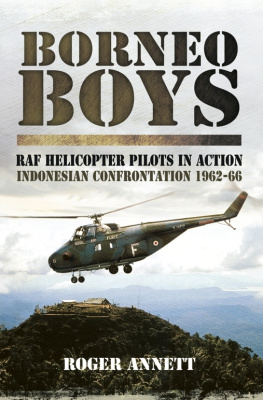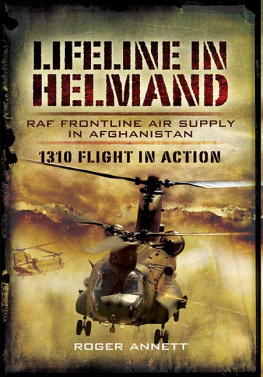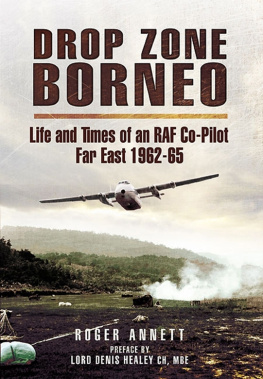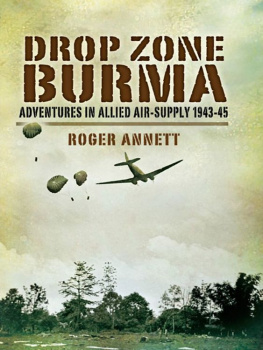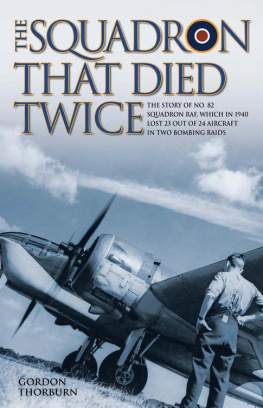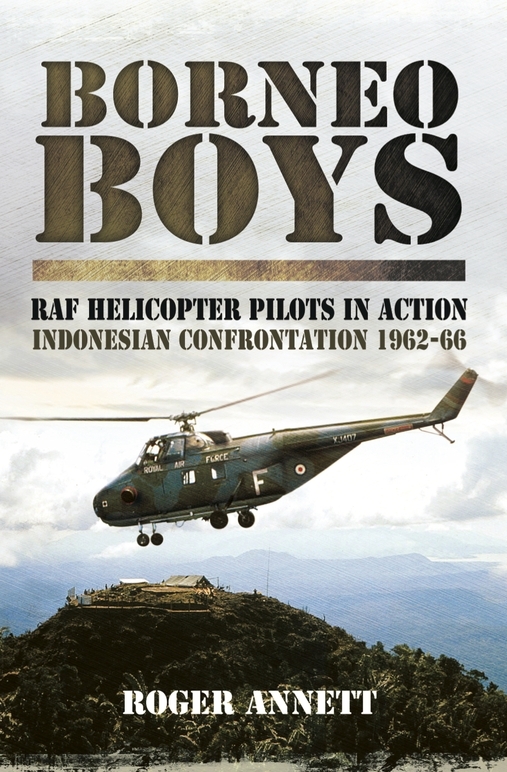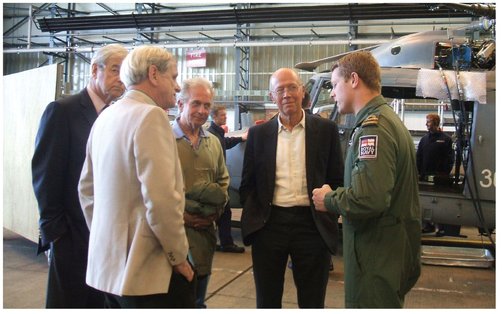Appendix 1
Post-Borneo Curricula Vitae
Borneo Boys in order of appearance in the story
Colin Ford Whirlwind pilot, 110 and 103 Squadrons RAF
On repatriation in 1966, for his time on 103 Squadron, Colin Ford was awarded the Queens Commendation for Valuable Services in the Air. He completed the four-month QHI course before marrying Jan, his Seletar fiance. A number of ex-FEAF helicopter pilots, including Ian Morgan and Mick Charles, attended the wedding and, instead of swords, they formed an arch with Iban parangs . The wedding pictures were a gift from the same photographer who had taken the ones for the Day in the Life Of advertisement out in the Far East.
Old Rotorsvisiting 815 NAS (Lynx) hangar on Royal Naval Air Base Yeovilton, May 2011. Left to right: Rick Atkinson, Bob Turner, Dick Holmes, Mike McKinley and host Lt Ed Barham RN. (Author)
Colin enjoyed being a flying instructor, converting both ab initio and experienced fixed-wing pilots to the rewarding joys of helicopter flying. Among those he taught was an old friend who had been a fellow student and roommate thoughout flying training and who was converting from the V-force.
In 1968 Colin volunteered at very short notice for a posting to Hong Kong as Training Officer on the newly formed 28 Squadron, flying Whirlwinds out of RAF Kai Tak. Within a few hours his boss at Tern Hill turned up with a bottle of bubbly, three glasses and the good news that Colin had the job. Next morning he reported for met briefing dressed up in his old jungle-green combats.
Following his Hong Kong tour he returned to CFS(H) where he converted to the Sioux and became a tutor to QHI students. Later he was appointed the CFS(H) project officer for the introduction of the Gazelle helicopter and, together with a colleague, wrote the Instructor Handbook and Student Study Guide .
Promoted in 1974 to Squadron Leader, he was appointed OC 22 Squadron based at RAFThorney Island, West Sussex, with responsibility for SAR across the south of England. He again returned to Tern Hill in 1976, this time as the CFS Helicopter Examiner, responsible for the categorization of all QHIs in the three Services as well as by invitation advising several foreign air forces on rotary flying skills. He flew many helicopter types in all parts of the world.
Colin had transferred to the General List in 1964 while on 103 Squadron in Singapore, giving him the opportunity to retire at the age of thirty-eight. In 1979 he waived the option and, effectively, his flying days were over. He spent the remainder of his RAF service working in a variety of staff appointments in the MoD in Whitehall, which was within easy commuting distance from his home in Maidenhead. When he retired in 1996, aged fifty-five, he started his final journey in the RAF from Platform 1 of Paddington Station the very platform from which he had set off in 1960 for South Cerney and together with Sam Smith in 1963 had journeyed to Lyneham, Singapore and Borneo.
Since leaving the RAF Colin has had no desire for further employment and, with two grandchildren so far, he and Jan have found full satisfaction in their domestic and family life. Boredom, he says, is not in our vocabulary.
Mick Charles Whirlwind pilot, 110, 103 and 225 Squadrons RAF After the QHI course at Ternhill Mick spent a year on the staff during which he renewed his acquaintance with Jen, a girl who had grown up in the same village as he had.
From May to December 1967 he did a tour on SAR Whirlwinds in Khormaksar Base, Aden, and, out there, converted to the Wessex twin-engined, and with a cruising-speed of 115 knots compared to the Whirlwinds 90. It was also robust, as Mick found out when his aircraft was peppered with lead by a group who had just mortared the airfield. On return to the UK in 1968 he and Jen were married, spending their first three years together at ETPS at Boscombe Down Mick a qualified test pilot, flying the Puma and the Queens Flight Wessex.
They then changed climates for three years, with Mick taking up an exchange posting to Canada as a test pilot in Canada at AETE Cold Lake it was minus 40 degrees Centigrade on their arrival. While there Mick was promoted Squadron Leader and he and Jen had a daughter. In 1972, he was awarded the AFC. 1975 77 saw Mick appointed a Flight Commander on 33 Squadron (Pumas) and his one and only ground tour was in 1978 79, as TF1c heli training at Adastral House, London, commuting from Hampshire.
At the thirty-eight-year point, he seamlessly migrated to the CAA and on to the Accident Investigation Board, first in Victoria Square and later at Farnborough. He retired at the end of 2001 but kept his ATPL current until 2006. He still lectures at Cranfield on AIB subjects, using the Lockerbie investigation, which he drove, as his case-study. He serves one day a week in the Witness Service at Winchester Crown Court, drawing on his AIB experience of working sympathetically with witnesses to air accidents. His hobby is silversmithing, for which he attends the courses and workshop at West Dean College, Chichester.
Mick reckons that no one could ask for a better first tour than his in Borneo: Lovely country and people, all the responsibility that you could ask for at age twenty-one, plenty of flying and making a difference. Even today, he still wears the watch he bought in Changi Village.
Ian Morgan Whirlwind pilot, 110, 103 and 225 Squadrons RAF Following his time on the staff at CFS(H) Ian moved on to instruct on the Wessex OCU at Odiham, thence to 72 Squadron, also at Odiham, as Training Officer before a brief spell as Wing Examiner.
Then, in 1969, he was selected for an exchange posting to the USAAC at Fort Rucker, Alabama training pilots on Huey helicopters for Vietnam. It was a strange situation in that many of the instructors were warrant officers and Ian, although still a Flight Lieutenant, had the seniority to be appointed second-in-command of a US Army training regiment with some eighty-eight aircraft on strength. It was a challenge which he thoroughly enjoyed.
After promotion to Squadron Leader, Ian had just one more flying tour, as Deputy CFI Middle Wallop. He married at thirty-five and took his new wife to Hong Kong and a staff job in the Joint Secretariat, working on a range of sensitive issues with the Hong Kong government.
He attended Staff College in 1979, after which spells at HQ 38 Group and at HQ STC preceded three tours at MoD. He was promoted to Wing Commander and moved to Air Plans where he co-ordinated the RAFs long-term costs. In his final MoD appointment, with responsibility for drafting the RAF Management Plan and a system for Performance Reporting against its required standards, he took an MBA.
Armed with that he retired from the RAF at the age of fifty-five and became CEO of a professional association of lawyers, accountants and bankers specializing in Private Client Trust Law, with offices in Jermyn Street. A move to the field of private equity saw him working on the acquisition of a number of corporate and family businesses until 2008 when the international credit crisis led him to head for final retirement.

